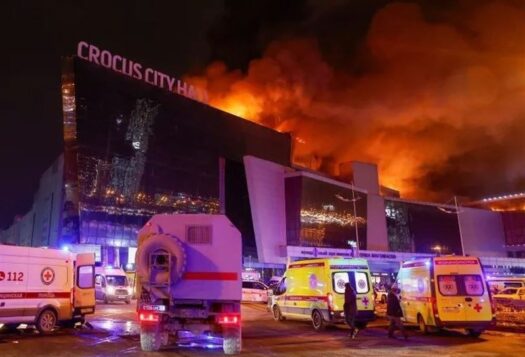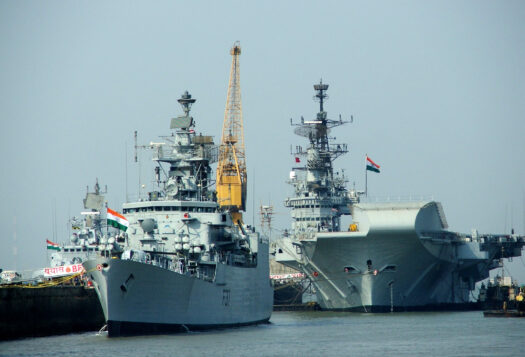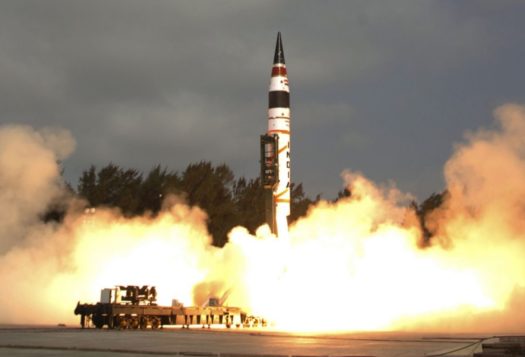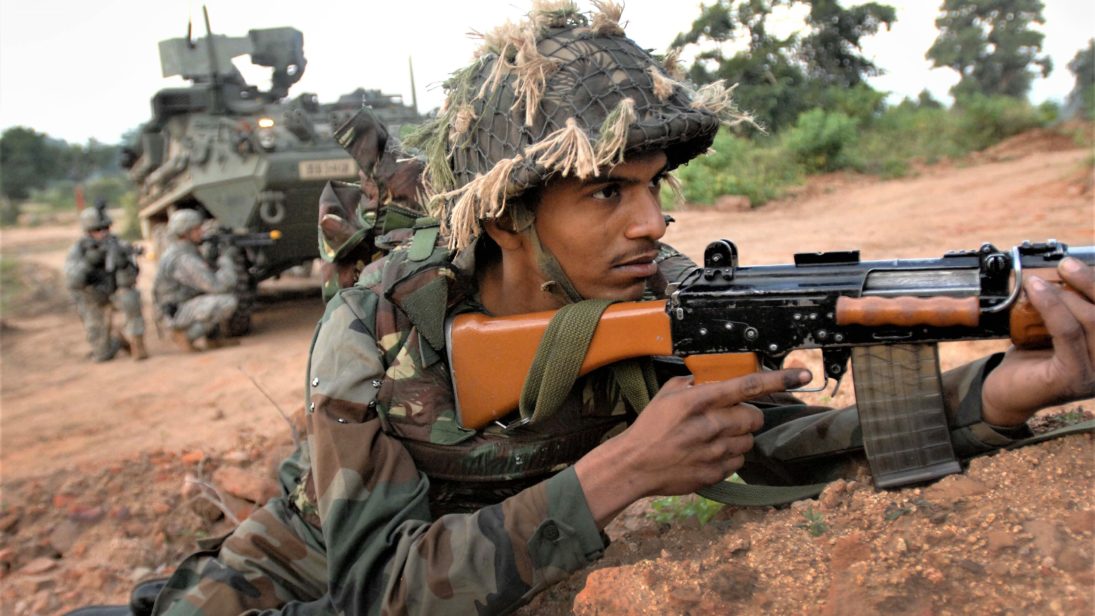
India’s military threat landscape today consists of territorial and resource-related disputes with Pakistan in its west and northwest and with China in the east and northeast. The nature of the threats India faces from Pakistan have morphed from conventional to asymmetric warfare over time, whereas China poses a conventional challenge supplemented with other modes of warfare and competition over maritime control across the Indian Ocean. This comes amid the advent of the China-Pakistan Economic Corridor (CPEC), as well as deepening China-Pakistan defense ties that have blunted some of the outright conventional advantage that India has historically enjoyed over Pakistan. As both countries seek to intensify their military cooperation with a series of joint military exercises and patrols, some in proximity to disputed Kashmir territory, Indian analysts and policy experts have argued that the two territorial threats of Beijing and Islamabad are converging into a single military threat.
Indian conventional military strategy, however, does not seem to be a function of these threats, because the Indian strategic community lacks concurrence on how the threat landscape exists today or is evolving. In fact, India’s conventional military doctrines, postures, and modernization trends are not oriented towards a coherent strategy.
India’s Threat Landscape: Confronting a Two-Front War?
Statements made in the open by Indian army officials on the prospect of a two-front threat landscape have been disparate: at times, officials have advocated that India can deter Pakistan while managing the relationship with China, while at other times they have asserted that India is capable of countering an all-out two-front war scenario. However, India’s command structure does not give the impression that this threat is being taken seriously. Firstly, the absence of a Chief of Defense Staff (CDS) or a Permanent Chairman Chiefs of Staff (PCCOS) is a vulnerability, as both are necessary for coordination between services if such a threat were to present itself. In addition, the planned reorganization of the 17 single-service commands into tri-service theater commands—which have military assets of all services under their control in an specified area—is stalled. This is necessary for optimum utilization of limited military assets if a coordinated two-front threat were to materialize.
Any measures to improve or achieve “jointness”…have not been taken due to turf-wars and debates over the ownership of military assets between the three services. This contention has rendered the task of reshaping India’s force structure to best confront the two-front threat of China and Pakistan challenging.
There is an ongoing debate within the three services of the Indian military about the concept of the reorganization of theater commands (i.e. theaterization) and what it might imply for India’s military preparedness at the strategic, operational, or tactical levels. However, any measures to improve or achieve “jointness,” a term that denotes the ability of the three services of the Indian military to act jointly to confront a threat, have not been taken due to turf-wars and debates over the ownership of military assets between the three services. This contention has rendered the task of reshaping India’s force structure to best confront the two-front threat of China and Pakistan challenging. Together, the absence of such reforms indicates that in the near term, India’s conventional military strategy is not motivated by a two-front threat perception.
The Other Adversary
If the Indian military is not motivated by fears of a two-front war, is it motivated by its threat perception regarding its eastern neighbor and rival, China? After all, Beijing has superior conventional forces supplemented with current and emerging cyber and electronic warfare capabilities.
In 2017, the Integrated Defense Staff (IDS) released the first public Joint Doctrine for the Indian Armed Forces (JDIAF). As the name suggests, the joint doctrine was supposed to clearly articulate a strategy that could appreciate the role of three services individually and in unison to cater to India’s entire threat spectrum. Although the JDIAF identifies that the Line of Actual Control (LAC) is a potential flashpoint, its reticence on China is palpable due to no mention of the Andaman and Nicobar Islands (ANI) Tri-Service Command in the document. Given that the ANI Command which plays a crucial role in force projection over the Sea Lines of Communication (SLOCs) in the Indian Ocean and the Malacca Strait upon which China depends for the shipping its exports and imports, its absence in the JDIAF is striking.
The JDIAF’s neglect of China is also evident in the its subordination of the roles of air and naval power. Naval and aerial forces offer more than land forces in terms of speed, stand-off, and force projection capabilities. However, the JDIAF posits a confined interpretation of the roles for these forces due to its army-centric and “overwhelmingly continental view” of the threats facing India.
Lack of Strategic Direction
Though the JDIAF envisions a military strategy oriented towards fighting a limited conflict on land with Pakistan, the IAF seems to be preparing to fight a two-front war. This year’s IAF-led Gagan Shakti exercises, which focused on the deployment and employment of air power and joint operations conducted in two phases on the Pakistani and Chinese fronts and across the entire Indian Ocean Region (IOR) demonstrates that the IAF envisions an array of threats beyond India’s land borders.
The JDIAF also underscores India’s ability to execute limited offensive war strategies to deter threats emanating from the Line of Control and the Line of Actual Control. However, this emphasis on limited offensives runs against each of the services of the Indian military, whose doctrines, reviews, and public statements increasingly suggest punishment and nuclear warfighting strategies. For instance, the Gagan Shakti exercises included “dedicated contingencies…towards sustaining operations in a Chemical, Biological, Radiological, and Nuclear attack scenario.” Interestingly, the Vijay Prahar exercise conducted by the Indian Army (IA) practiced “fighting dirty” even after the nuclear threshold is breached, contradicting the stated deterrence aims of the JDIAF. More significantly, the Chief of Air Staff has stated that the IAF has the ability to independently “locate, fix, and strike” tactical nuclear weapons (TNW) batteries if necessary, although it may cause a nuclear detonation. IA’s own exercise and IAF’s simulations go against the fundamental tenets of fighting a limited battle in the JDIAF by wading into the nuclear realm of the conflict.
The doctrinal incoherence between JDIAF and the different services of the Indian military—as well as the differences between what is promulgated and what is practiced in exercises—serves as evidence that there is no unified understanding within the Indian military of the country’s threat landscape or the strategies that should be employed to confront them.
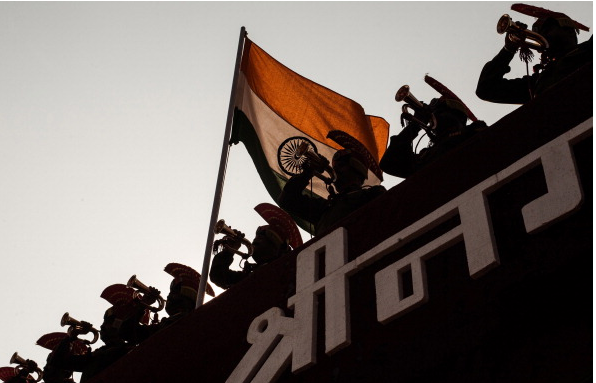
Modernization and Defense Expenditure Trends
Modernization trends also convey an underappreciation of the emerging threat landscape as well as an enduring continental threat perception. Like any other nation, India faces a trade-off between managing expenditure on social welfare programs and defense spending; this automatically places a bar on the money that is available for military modernization purposes. Ajai Shukla, a defense journalist, writes that India’s total defense budget is approximately 2 percent of GDP. Significantly, for a military preparing for future conflicts, the overall allocations for the 2018-19 for the IAF and Indian Navy (IN)stand at only 23 and 15 percent of the total defense budget, respectively, compared to 55 percent for the IA.
With revenue budgets (due to large numbers of personnel) eating into the capital expenditure requirements of all three services, even the sanctioned or contracted modernization requirements and projects are seldom met due to procedural delays or financial impediments. The IAF may only have 29 combat squadrons against the requirement of 42 by 2022, while the IN maintains only 140 warships against the need for 198 by 2027. The end result is an incremental modernization process that lacks the speed to respond to any overarching conception of what future threats might hold.
Conclusion
India has multitude of doctrines, postures, and tactics—but absent a coherent strategy, the armed services are operating in their own silos. There is a lack of concurrence on the exact nature and necessities of the threat landscape and the requirements of future warfare. The absence of theaterization and conceptual differences over jointness are motivated by concerns ranging from service primacy to the ownership of military assets.
India’s conventional military prowess is largely a function of disoriented ad-hoc capabilities, doctrines, and postures that reflect service-specific concerns and roles, but not a strategy.
In this context, India’s conventional military prowess is largely a function of disoriented ad-hoc capabilities, doctrines, and postures that reflect service-specific concerns and roles, but not a strategy. One way India could ameliorate the situation might be to draft a written national security strategy document that would help to outline the primary tenets of a comprehensive defense strategy. Until then, the natural outcome of the current scenario is an organizational set-up in which services address the threat spectrum only in the way they perceive it, while the doctrines, postures, and strategies constituting India’s conventional military strategy are all formulated in silos.
Editor’s Note: Ten years after the 26/11 attacks stunned Mumbai and nearly led to a military confrontation between India and Pakistan, the nuclear-armed rivals continue to update and transform their conventional and nuclear military doctrines, postures, and strategies. SAV contributors Joy Mitra, Ali Ahmed, Maimuna Ashraf, and Sannia Abdullah reevaluate whether India and Pakistan are exhibiting strategic direction or drift. Read the series here.
***
Image 1: U.S. Department of Defense Website
Image 2: Yawar Nazir via Getty Images
